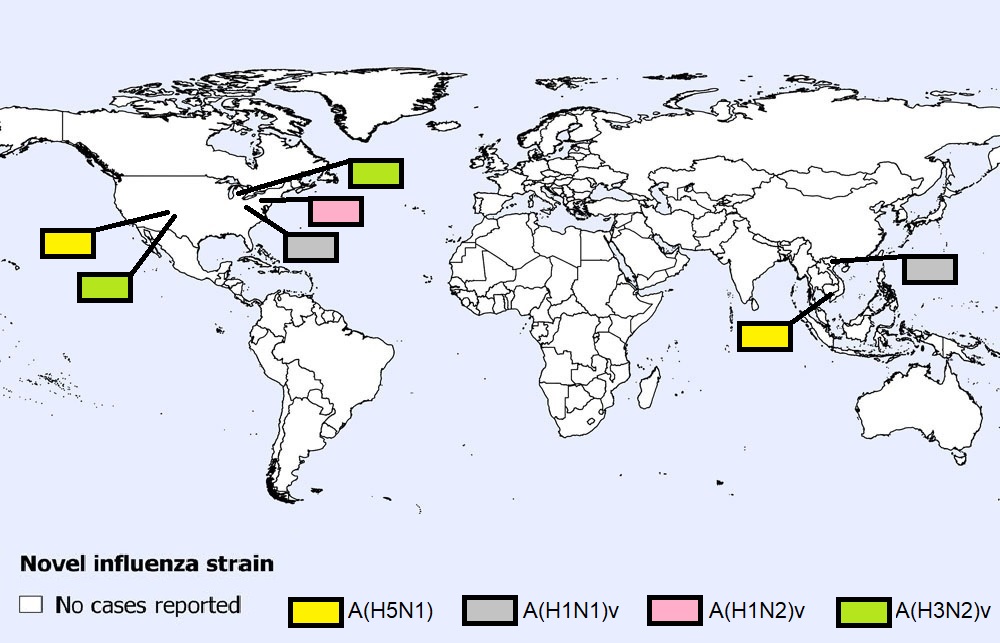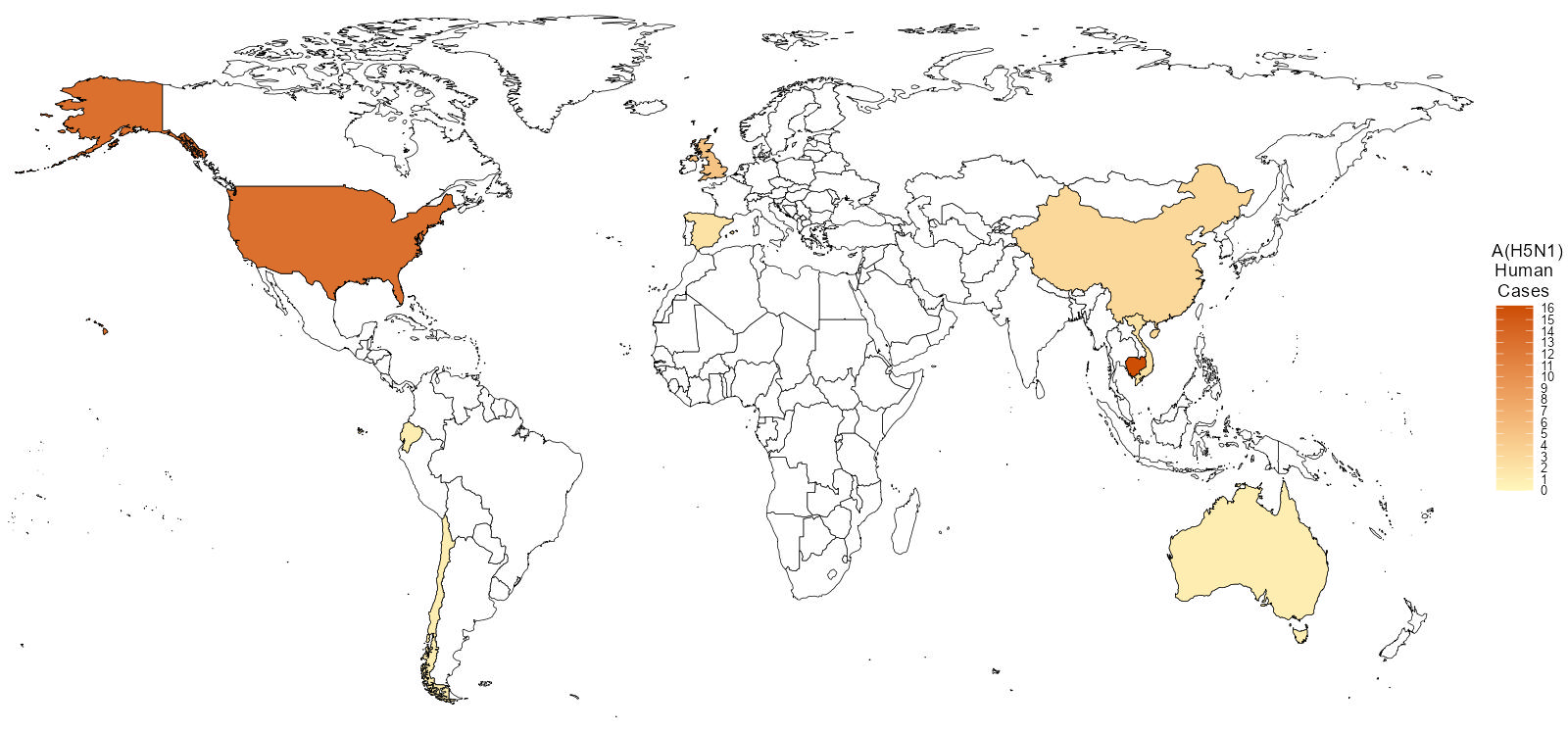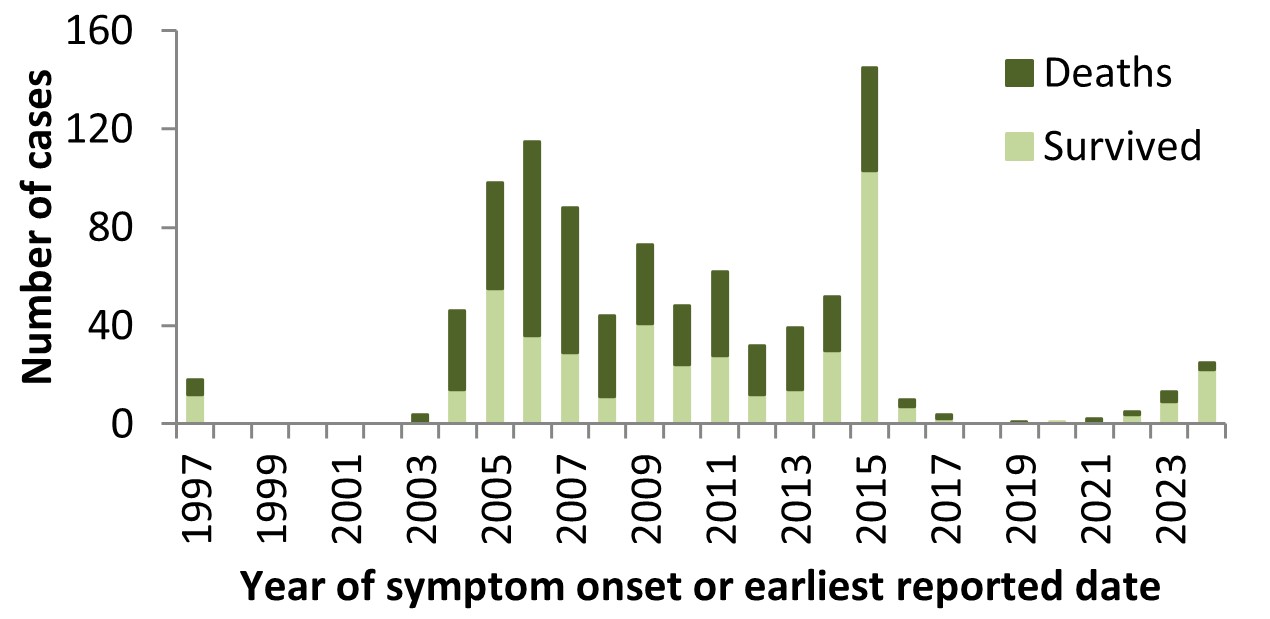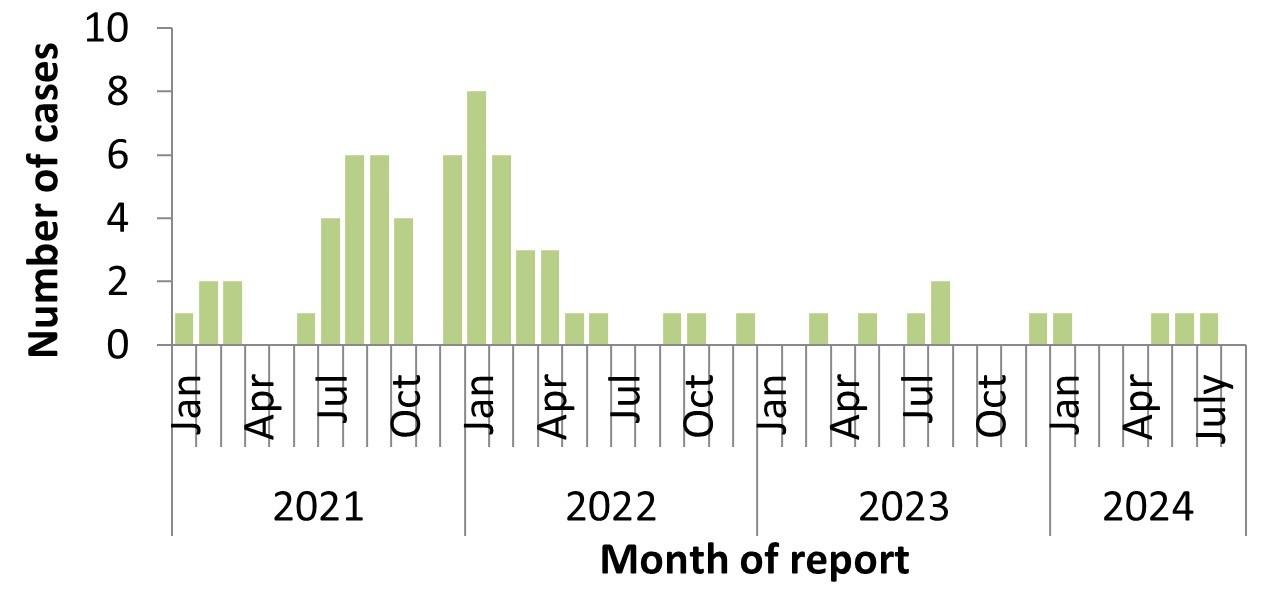Human emerging respiratory pathogens bulletin: Issue 92, August 2024

Download in PDF format
(618 KB, 5 pages)
Organization: Public Health Agency of Canada
Published: 2024-09-10
Cat.: HP38-6E-PDF
ISBN: 2563-9420
Pub.: 230012
Monthly situational analysis of emerging respiratory diseases affecting humans (data to August 31, 2024).
In this bulletin
- Avian influenza updates
- Swine influenza updates
- Middle East respiratory syndrome coronavirus (MERS-CoV) update
| Novel influenzaFootnote 1 | Cumulative Case CountFootnote 2 | Deaths | Case Fatality Rate %Footnote 3 | Date of Last ReportFootnote 4 |
|---|---|---|---|---|
| Avian Influenza | ||||
| A(H1N2)Footnote 5 | 2 | 0 | 0% | January 2019 |
| A(H3N8) | 3 | 1 | 33% | March 2023 |
| A(H5NX)Footnote 6 | 1 | 0 | 0% | July 2024 |
| A(H5N1) | 925 | 470 | 51% | August 2024 |
| A(H5N2) | 1 | 1 | 100% | May 2024 |
| A(H5N6) | 93 | 57 | 61% | July 2024 |
| A(H5N8) | 7 | 0 | 0% | February 2021 |
| A(H7N4) | 1 | 0 | 0% | February 2018 |
| A(H7N9) | 1,568 | 615 | 39% | April 2019 |
| A(H9N2) | 131 | 2 | 2% | July 2024 |
| A(H10N3) | 3 | 0 | 0% | April 2024 |
| A(H10N5) | 1 | 1 | 100% | January 2024 |
| Swine Influenza | ||||
| A(H1N1)v | 50 | 2 | 4% | August 2024 |
| A(H1N2)v | 55 | 0 | 0% | August 2024 |
| A(H3NX)vFootnote 7 | 1 | 0 | 0% | August 2023 |
| A(H3N2)v | 449 | 1 | <1% | August 2024 |
| A(H1NX)vFootnote 8 | 1 | 1 | 100% | November 2021 |
| Eurasian avian-like A(H1N1)v | 11 | 0 | 0% | September 2023 |
| MERS-CoVFootnote 1 | ||||
| Global Case CountFootnote 9 | 2,613 | 941 | 36% | May 2024 |
| - Within Saudi ArabiaFootnote 10 | 2,204 | 860 | 39% | May 2024 |
|
||||
The Human Emerging Respiratory Pathogens (HERP) Bulletin is a monthly publication developed by the Public Health Agency of Canada (PHAC)'s Centre for Emerging and Respiratory Infections and Pandemic Preparedness (CERIPP). The HERP Bulletin serves as a mechanism for information sharing on summary surveillance indicators of global, including domestic, public health events affecting humans in the field of emerging respiratory pathogens. This includes pathogens such as novel influenzas (both avian and swine-origin), Middle East Respiratory Syndrome Coronavirus (MERS-CoV), and other ad-hoc emerging respiratory pathogens.
Monthly Highlights
Events in Canada
No human cases of emerging respiratory infection have been detected in Canada since the last detection in July 2024 (see HERP Bulletin no 91).
International Events
During the month of August 2024, the following human cases have been reported (Figure 1):
- Six new human cases of avian influenza A(H5N1)
- Two new human cases of swine influenza A(H1N1)v
- One new human case of swine influenza A(H1N2)v
- Two new human cases of swine influenza A(H3N2)v

Figure 1 - Text description
Three (3) A(H5N1) cases were reported in Cambodia.
Three (3) A(H5N1) cases were reported in the United States.
One (1) A(H1N1)v case was reported in the United States.
One (1) A(H1N1)v case was reported in Vietnam.
One (1) case of A(H1N2)v was reported in the United States.
Two (2) A(H3N2)v cases were reported in the United States.
Note: Map was prepared by CERIPP using data from the latest WHO Event Information Site (EIS) postings. This map reflects data available through these publications as of August 31, 2024.
Avian influenza updates
Avian influenza A(H5N1)
Three new human cases of avian influenza A(H5N1) were reported in August 2024 from Cambodia and three human cases of A(H5NX) from the US were confirmed to be A(H5N1).
None of the three human cases from Cambodia were epidemiologically linked and none had underlying medical conditions. The first two cases were a 4-year-old male and a 16-year-old female from Svay Rieng province. The third case was a 15-year-old female from Prey Veng province. All three cases developed severe respiratory symptoms, were hospitalized, treated with antivirals, and reported exposure to dead poultry prior to illness onset. At the time of last report, one case was in stable condition, one was in serious condition on mechanical ventilation, and one case was fatal. No additional cases related to these events have been reported.
In August 2024, three human A(H5NX) cases that were previously reported in July 2024 (see HERP Bulletin no 91) in the United States were confirmed to be avian influenza A(H5N1). These three human cases were working on a commercial poultry farm in Colorado. The viruses belong to clade 2.3.4.4b and are similar to the viruses found in poultry and dairy cattle in the US.
In 2024, 25 human cases of avian influenza A(H5N1) have been detected worldwide, from Australia (1), Cambodia (10), China (1), the United States (12), and Vietnam (1). This case count does not include one A(H5NX) human case in the US (1) that the US CDC was not able to determine the neuraminidase (NA) subtype of. Since the start of the ongoing A(H5N1) worldwide outbreak in poultry and other animals in December 2021, 44 human cases of A(H5N1) have been reported worldwide (2022: n=6, 2023: n=13, 2024: n=25) in Australia (1), Cambodia (16), Chile (1), China (3), Ecuador (1), Spain (2), United Kingdom (5), United States (13), and Vietnam (2) (Figure 2). Of these cases, 20 of the viruses belong to the same strain of A(H5N1) that is associated with the current global outbreak in animals (clade 2.3.4.4b), 1 is tentatively from this same strain, 12 cases were infected with viruses that belonged to a different strain of A(H5N1) (clade 2.3.2.1c), and 1 is from clade 2.3.2.1a. The clade details of five cases from Cambodia, the travel-related case from China, and four cases from the US are unknown.
Since the emergence of A(H5N1) in humans in 1997, 925 human cases of A(H5N1) have been reported globally, with a CFR of 51% (Figure 3). In Canada, A(H5N1) detections associated with the current 2021-2024 A(H5N1) clade 2.3.4.4b epizootic have been reported in domestic, backyard, and wild bird populations, as well as other animal species. HPAI A(H5N1) has not been detected in dairy cattle, other livestock in Canada, or in raw milk. No domestically acquired human A(H5N1) infections have ever been reported in Canada; however, in 2014, Canada (Alberta) reported a single fatal case of A(H5N1) in a resident returning from travel in China.

Figure 2 - Text description
Sixteen (16) cases were reported out of Cambodia.
Five (5) cases were reported out of the United Kingdom.
Three (3) cases were reported out of China.
Two (2) cases were reported out of Spain.
One (1) case was reported out of Chile.
One (1) case was reported out of Ecuador.
Thirteen (13) cases were reported out of the United States of America.
Two (2) cases were reported out of Vietnam.
One (1) case was reported out of Australia.
Note: Map was prepared by CERIPP using data from the WHO EIS postings, the US CDC's Health Alert Network (HAN), and WHO cumulative case counts. This map reflects data available as of August 31, 2024.

Figure 3 - Text description
| Number of Cases | Deaths | Survived | |
|---|---|---|---|
| 1997 | 18 | 6 | 12 |
| 1998 | 0 | 0 | 0 |
| 1999 | 0 | 0 | 0 |
| 2000 | 0 | 0 | 0 |
| 2001 | 0 | 0 | 0 |
| 2002 | 0 | 0 | 0 |
| 2003 | 4 | 4 | 0 |
| 2004 | 46 | 32 | 14 |
| 2005 | 98 | 43 | 55 |
| 2006 | 115 | 79 | 36 |
| 2007 | 88 | 59 | 29 |
| 2008 | 44 | 33 | 11 |
| 2009 | 73 | 32 | 41 |
| 2010 | 48 | 24 | 24 |
| 2011 | 62 | 34 | 28 |
| 2012 | 32 | 20 | 12 |
| 2013 | 39 | 25 | 14 |
| 2014 | 52 | 22 | 30 |
| 2015 | 145 | 42 | 103 |
| 2016 | 10 | 3 | 7 |
| 2017 | 4 | 2 | 2 |
| 2018 | 0 | 0 | 0 |
| 2019 | 1 | 1 | 0 |
| 2020 | 1 | 0 | 1 |
| 2021 | 2 | 1 | 1 |
| 2022 | 5 | 1 | 4 |
| 2023 | 13 | 4 | 9 |
| 2024 | 25 | 3 | 22 |
Note: Graph was prepared by CERIPP using data from the WHO EIS postings, the US CDC's Health Alert Network (HAN), and WHO cumulative case counts. This graph reflects data available as of August 31, 2024.
Avian influenza A(H5N2)
The most recent human case of avian influenza A(H5N2) was reported in May 2024 from Mexico.
This was the first ever human case of avian influenza A(H5N2). Since only one human case of A(H5N2) has been reported to date and the availability of clinical information is limited, the full spectrum of disease is unknown.
Avian influenza A(H5N6)
The most recent human case of avian influenza A(H5N6) was reported in July 2024 from China.
In August 2024, the World Health Organization updated their A(H5N6) death count, which increased by 19 deaths. All of these reported deaths were outcomes of previously reported human cases of A(H5N6) in China. Therefore, the global CFR of A(H5N6) increased from 41% to 61%.
Since January 2021, 67 cases of avian influenza A(H5N6) have been reported globally (2021: n=32, 2022: n=25, 2023: n=5, 2024: n=4) (Figure 4); all but one case (2021, Lao PDR) were reported in China. Since the emergence of this virus in 2014, a total of 93 laboratory-confirmed human cases of avian influenza A(H5N6), including at least 57 deaths, have been reported globally (CFR: 61%). No cases have been reported in Canada.

Figure 4 - Text description
| Month | Cases | |
|---|---|---|
| 2021 | Jan | 1 |
| Feb | 2 | |
| Mar | 2 | |
| Apr | 0 | |
| May | 0 | |
| June | 1 | |
| July | 4 | |
| Aug | 6 | |
| Sep | 6 | |
| Oct | 4 | |
| Nov | 0 | |
| Dec | 6 | |
| 2022 | Jan | 8 |
| Feb | 6 | |
| Mar | 3 | |
| Apr | 3 | |
| May | 1 | |
| June | 1 | |
| July | 0 | |
| August | 0 | |
| Sep | 1 | |
| Oct | 1 | |
| Nov | 0 | |
| Dec | 1 | |
| 2023 | Jan | 0 |
| Feb | 0 | |
| Mar | 1 | |
| Apr | 0 | |
| May | 1 | |
| June | 0 | |
| July | 1 | |
| August | 2 | |
| Sep | 0 | |
| Oct | 0 | |
| Nov | 0 | |
| Dec | 1 | |
| 2024 | Jan | 1 |
| Feb | 0 | |
| Mar | 0 | |
| Apr | 0 | |
| May | 1 | |
| June | 1 | |
| July | 1 | |
| August | 0 |
Note: Graph was prepared by CERIPP using data from the WHO EIS postings and the Hong Kong Centre for Health Protection (CHP) press releases. This graph reflects data available as of August 31, 2024.
Avian influenza A(H9N2)
The most recent human case of avian influenza A(H9N2) was reported in July 2024 from China.
In 2024, nine human cases of avian influenza A(H9N2) have been reported worldwide, from China (7), India (1), and Vietnam (1). In 2023, a total of 15 human cases of avian influenza A(H9N2) were reported globally, all in China. Since the emergence of avian influenza A(H9N2) in the human population in 1998, 131 cases have been reported worldwide, with a CFR of 2%. No cases have been reported in Canada.
Avian influenza A(H10N3)
The most recent human case of avian influenza A(H10N3) was reported in April 2024 from China.
In 2024, one human case of avian influenza A(H10N3) has been reported worldwide. Since the emergence of avian influenza A(H10N3) in humans in 2021, three human cases have been reported, all from China, with a CFR of 0%. However, with only three human cases reported to date, the full spectrum of disease is highly uncertain. No cases have been reported in Canada.
Swine influenza updates
Swine origin influenza A(H1N1)v
Two new human cases of swine origin influenza A(H1N1)v were reported in August 2024 from the US (1) and Vietnam (1).
The first case was an individual >18-years-old from Ohio, US. The case developed acute respiratory illness with cough, congestion, fever and headache. The case was hospitalized due to an underlying chronic medical condition. The case received antiviral treatment and has since recovered. Prior to illness onset, the case had exposure to swine at an agricultural fair in Ohio. Respiratory illness was not identified in any close contacts of this case.
The second case was a 70-year-old female from Son La province, Vietnam. The case had hypertension and diabetes as comorbidities. After returning from a trip to another village, the case was hospitalized with fever, cough and intermittent vomiting. She was provided antivirals but died on June 11, 2024. The case had limited contact with other villagers or caretakers during her illness. The exposure source is unknown. Respiratory symptoms have not been reported among close contacts of this case.
In 2024, four human cases of swine origin influenza A(H1N1)v have been detected worldwide. There have been five human A(H1N1)v cases reported worldwide in 2023 in Brazil (1), China (2), Spain (1) and Switzerland (1). A total of 50 human cases of A(H1N1)v have been reported globally since 2005, with a 4% CFR. Two A(H1N1)v detections have been reported in Canadian residents since reporting began in 2005, with the first case reported in Ontario in September 2012 and the second case reported in Manitoba in April 2021 (see HERP Bulletin no 52).
Swine origin influenza A(H1N2)v
One new human case of swine origin influenza A(H1N2)v was reported in August 2024 from the US.
The case was an individual >18-years-old from Pennsylvania, US. The case developed symptoms and was hospitalized due to underlying medical conditions. The case has since recovered. Prior to illness onset, the case had occupational exposure to swine. No secondary cases were reported and no human-to-human transmission related to this case was identified.
In 2024, three human cases of swine origin influenza A(H1N2)v were detected worldwide, all in the United States. In 2023, four human swine origin influenza A(H1N2)v cases were reported worldwide in Taiwan (1), the UK (1), and the United States (2). A total of 55 human cases of swine origin influenza A(H1N2)v have been reported globally since 2005, with a 0% CFR. Three swine origin influenza A(H1N2)v detections have been reported in Canadian residents since reporting began in 2005. The first case was reported in Alberta in October 2020 (see HERP Bulletin no 46), the second case was reported in Manitoba in April 2021 (see HERP Bulletin no 52) and the latest case in Canada was reported in November 2021 in Manitoba (see HERP Bulletin no 59).
Swine origin influenza A(H3N2/H3NX)v
Two new human cases of swine origin influenza A(H3N2)v were reported in August 2024 from the United States.
The first case was reported from Colorado in an individual <18-years-old. The case developed symptoms of fever, shortness of breath, and fatigue and sought medical care. The case was not hospitalized and did not receive antivirals. The case has since recovered. Prior to illness onset, the case attended an agricultural fair. No secondary cases were reported and no human-to-human transmission related to this case was identified.
The second case was reported from Michigan in an individual <18 years of age. The case sought healthcare and was admitted to hospital due to a pre-existing condition. As of the time of last report, the case was recovering. No exposure to swine or attendance at an agricultural event prior to illness onset was reported. No secondary cases were reported and no human-to-human transmission related to this case was identified.
To date, three human cases of swine origin influenza A(H3N2)v have been reported worldwide in 2024, from Canada (1) and the United States (2). Excluding the reported case of A(H3NX)v in the United States (1), no cases of swine origin influenza A(H3N2)v were detected in 2023. Globally, 449 swine origin influenza A(H3N2)v cases have been reported since 2005, with <1% CFR. Four human cases of swine origin influenza A(H3N2)v have been reported in Canada since 2005. The first case of A(H3N2)v in Canada was reported in Ontario in 2005. This was followed by a second case in Ontario in 2016, a third case in Manitoba in June 2021 (see HERP Bulletin no 54), and a fourth case in Saskatchewan in July 2024 (see HERP Bulletin no 91).
Middle East respiratory syndrome coronavirus (MERS-CoV) update
The most recent human cases of MERS-CoV were reported in May 2024 from Saudi Arabia.
To date, five new human cases of MERS-CoV have been reported in 2024, all from Saudi Arabia. In 2023, ten cases of MERS-CoV were reported in Oman (1), Saudi Arabia (8), and the United Arab Emirates (1). According to the WHO, 2,613 laboratory-confirmed cases of MERS-CoV, including 941 deaths, have been reported globally since reporting began in 2012 (CFR: 36%) (Figure 5). No cases have ever been reported in Canada.

Figure 5 - Text description
| Deaths | Survived | ||
|---|---|---|---|
| 2019 | Jan | 5 | 14 |
| Feb | 14 | 62 | |
| Mar | 3 | 26 | |
| Apr | 11 | 11 | |
| May | 4 | 10 | |
| June | 1 | 6 | |
| July | 4 | 5 | |
| Aug | 1 | 5 | |
| Sep | 1 | 3 | |
| Oct | 6 | 8 | |
| Nov | 2 | 10 | |
| Dec | 3 | 2 | |
| 2020 | Jan | 5 | 15 |
| Feb | 5 | 14 | |
| Mar | 5 | 10 | |
| Apr | 0 | 2 | |
| May | 5 | 2 | |
| June | 0 | 0 | |
| July | 0 | 0 | |
| Aug | 0 | 0 | |
| Sep | 0 | 0 | |
| Oct | 0 | 0 | |
| Nov | 1 | 3 | |
| Dec | 0 | 3 | |
| 2021 | Jan | 0 | 0 |
| Feb | 3 | 3 | |
| Mar | 1 | 1 | |
| Apr | 0 | 0 | |
| May | 1 | 0 | |
| June | 0 | 1 | |
| July | 0 | 2 | |
| Aug | 1 | 0 | |
| Sep | 0 | 0 | |
| Oct | 0 | 1 | |
| Nov | 0 | 0 | |
| Dec | 3 | 0 | |
| 2022 | Jan | 0 | 0 |
| Feb | 0 | 0 | |
| Mar | 0 | 1 | |
| Apr | 1 | 0 | |
| May | 2 | 2 | |
| June | 0 | 0 | |
| July | 0 | 0 | |
| August | 0 | 0 | |
| Sep | 0 | 0 | |
| Oct | 0 | 0 | |
| Nov | 41 | 4 | |
| Dec | 0 | 1 | |
| 2023 | Jan | 0 | 2 |
| Feb | 0 | 0 | |
| Mar | 1 | 1 | |
| Apr | 0 | 0 | |
| May | 0 | 0 | |
| June | 0 | 0 | |
| July | 0 | 1 | |
| August | 2 | 1 | |
| Sep | 0 | 0 | |
| Oct | 0 | 0 | |
| Nov | 1 | 2 | |
| Dec | 0 | 0 | |
| 2024 | Jan | 0 | 0 |
| Feb | 1 | 0 | |
| Mar | 0 | 0 | |
| Apr | 1 | 0 | |
| May | 1 | 2 | |
| June | 0 | 0 | |
| July | 0 | 0 | |
| August | 0 | 0 |
Note: Graph was prepared by CERIPP using data from the WHO Disease Outbreak News (DON) and Saudi Arabia's Ministry of Health. This graph reflects data available as of August 31, 2024. The data integrates CERIPP real-time reporting with WHO DON retrospective reporting of MERS-CoV cases and deaths. In November 2022, the WHO published a DON article that updated their counts with retrospective cases and deaths, which resulted in an increase of an additional 5 cases and 41 deaths compared to their previous MERS-CoV-related DON. In August 2023, the WHO published a DON article with case information for three retrospective MERS-CoV cases and two deaths. These three cases and one death were already reflected in the cumulative case count of the DON article published in July 2023, as well as the case totals published in HERP Bulletin no 79. In May 2024, the WHO published a DON article with case information for one single, fatal case of MERS-CoV. This fatal case was already reflected in the case totals published in HERP Bulletin no 88.